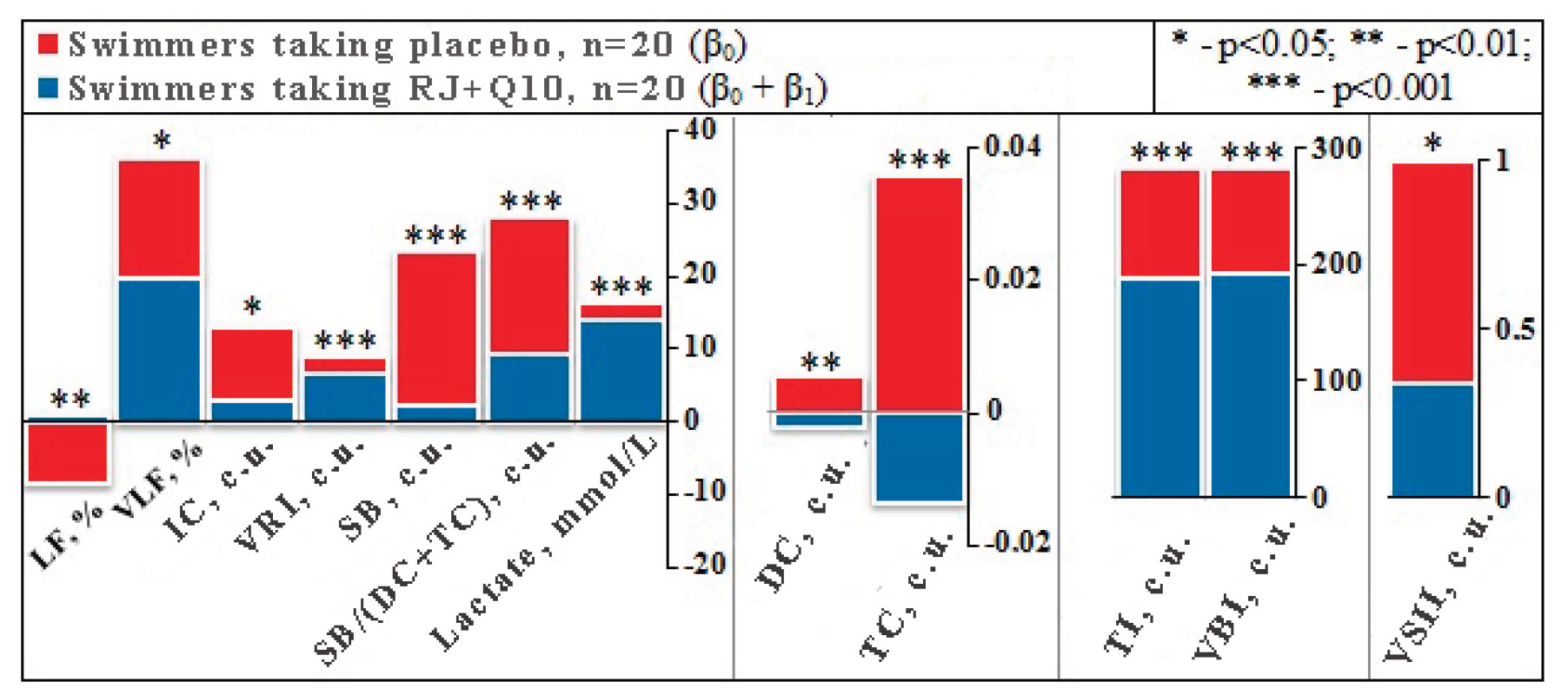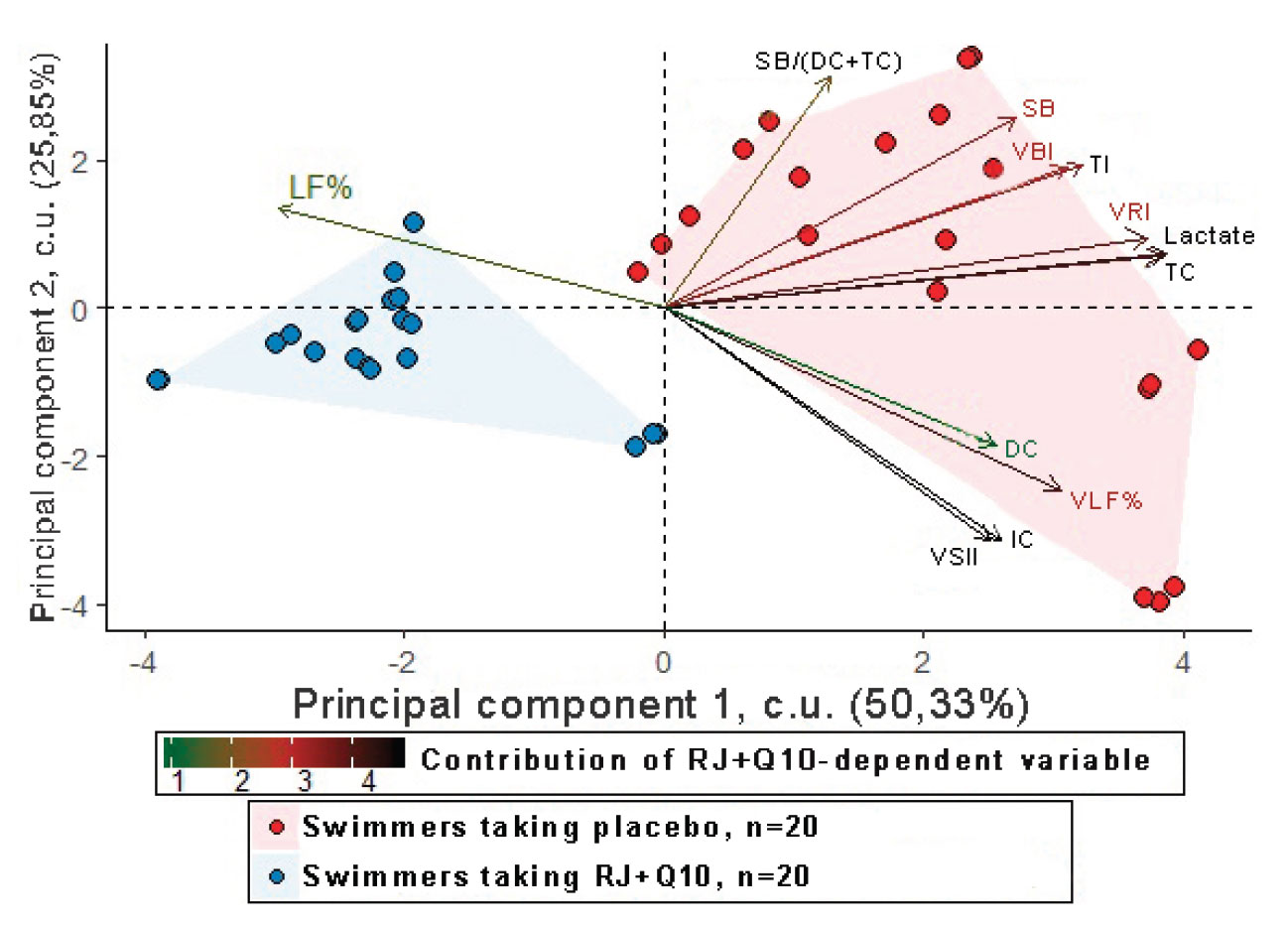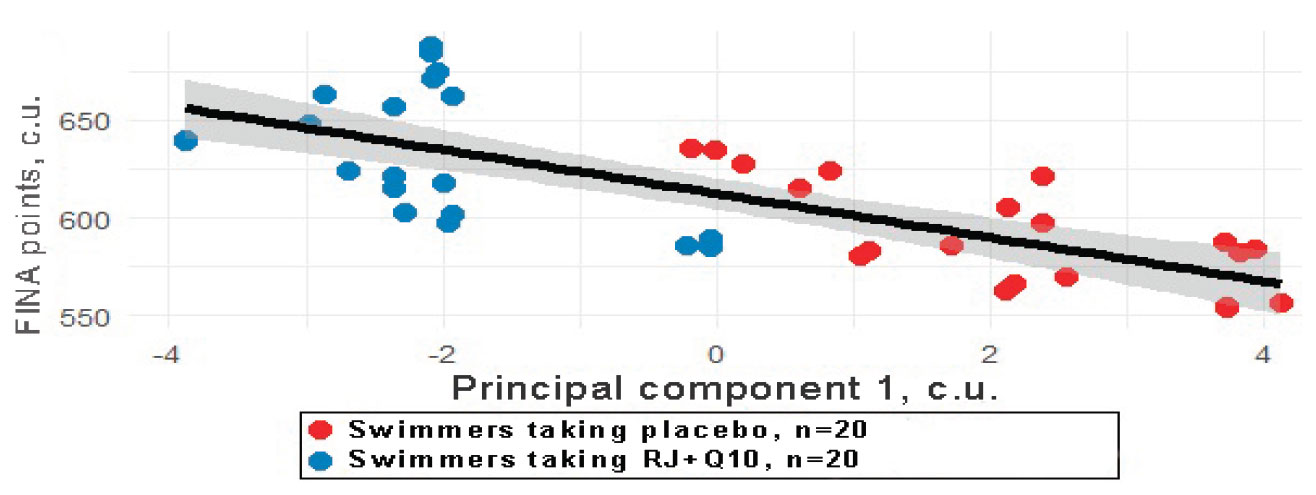Effects of composition of ubiquinone-10 and royal jelly on physiological and biochemical correlates of improved physical activity rates in highly qualified athletes
ˑ:
Postgraduate A.N. Ovchinnikov1
Dr. Biol., Associate Professor A.V. Deryugina1
1Lobachevsky State University of Nizhny Novgorod - National Research University, Nizhny Novgorod
Keywords: royal jelly, ubiquinone-10, heart rate variability, oxidative stress, metabolic acidosis, highly qualified athletes, athletic performance.
Background. The analysis of heart rate variability and oxidative stress level makes it possible to determine the degree of bodily adaptation to different stimuli. The enhancement of adaptive processes in the body underlies the development of athletes' physical qualities and improvement of athletic performance. In this view, the possibility to timely correct the functional state of the body without violating the anti-doping regulations is gaining particular importance. Royal jelly and ubiquinone-10 (Q10) can be among those biomodulators, not included in the WADA (World Anti-Doping Agency) list of prohibited substances, that have minimal side effects and can quickly integrate into damaged systems and restore them [2, 3]. Meanwhile, it was experimentally proved that, in case of combined use of these substances their impacts, the most important of which are trophic, antihypoxic, and antioxidant effects, may potentiate [1]. We believe that these effects can stimulate the development of adaptive changes in the body of athletes, which is reflected in the shifts in the physiological and biochemical indicators affecting their physical working capacity.
Objective of the study was to find a correlation between the physiological and biochemical indicators affected by the composition of royal jelly and Q10 and effectiveness of functional test execution by highly qualified athletes.
Methods and structure of the study. The study involved 40 highly qualified male swimmers aged 16 to 20 years. As a control exercise we used a series of segments 4x50 m covered using the main stroke with 45 sec of rest breaks in between. Based on the pretest results, we formed 2 groups of subjects with similar morphofunctional indicators. In the Control Group, the athletes were given honey (placebo) daily at a dose of 10 g/day for 10 days. In the Experimental Group, during the same period, the subjects were given the composition as follows: honey + royal jelly + Q10 at a dose of 10 g/day, including 400 mg/day of royal jelly and 60 mg/day of Q10. The substances were taken sublingually. Q10 is a microbiological synthesis product synthesized at OJSC "Kstovo Experimental Pilot Protein-Vitamin Concentrates Plant" according to the technology developed at the Research Institute "Sintezbelok" of the Russian Academy of Sciences and Research and Production Association "Vitaminy". Honey and royal jelly were extracted in the Federal Beekeeping Research Center.
The heart rate variability analysis was carried out using the hardware-software complex "Poly-spectrum-rhythm" (LLC "Neurosoft", Ivanovo). In the spectral analysis of heart rate variability, conducted based on the ECG signal recording data, three main frequency ranges in the heart rate fluctuations spectrum were highlighted: High Frequency, Low Frequency, Very Low Frequency [4], which characterized the contribution of the sympathetic and parasympathetic effects to the regulation of sinus node activity. We calculated the indicators characterizing the level of tension of the regulatory systems and stress reactivity of the body: index of tension of regulatory systems, vegetative balance index, vegetative rhythm index, vagosympathetic interaction index and index of centralization.
We measured the level of lipid peroxides in oral fluid and lactate in the blood of the athletes and took them as the clinical and laboratory criteria. The levels of dienoic conjugates (DC), trienoic conjugates (TC) and Schiff's bases (SB) were determined using the spectophotometer "SF-2000" ("Specialist Design Office SPEKTR", Russia). The lactate levels in the blood were measured using StatStrip Lactate Xpress laboratory portable analyzer ("NOVA Biomedical", USA).
The athletes' physical fitness level was assessed based on the preliminary testing results with the time of execution of the control exercise and the corresponding number of points by the FINA assessment system.
Before the start of the experiment, each athlete was informed in detail on the ongoing research and gave their written consent to participate. The study was organized and conducted in accordance with the ethical principles of the WMA Declaration of Helsinki [5].
Statistical data processing was performed in Microsoft Excel 2013 and Statistica 12, R. The results are presented as the dynamic shifts for each of the studied indicators during the execution of the control exercise (the difference between the post-load and pre-load rates). The effects of the composition of royal jelly and Q10 on the dynamics of changes in the studied indicators during the execution of the control exercise by the swimmers were determined according to the following regression model:
![]() ,
,
where Y – regressand; Dummy – dummy variable between 0 and 1 depending on the substance (0 = placebo, 1 = composition of royal jelly and Q10); β0 and β1 – estimated regression parameters; ε – modeling error.
We applied the method of principal components, calculated the Pearson's correlation coefficient and determination coefficient to rate the statistical relations between the shifts in the physiological and biochemical indicators, which were statistically significantly affected by the composition of royal jelly and Q10 (RJ+Q10-dependent variables), and the result of execution of the control exercise by the swimmers.
Results and discussion. The obtained models made it possible to compare the dynamics of shifts in each indicator in the group of swimmers taking the composition of royal jelly and Q10 and the group of swimmers taking placebo. These models showed that, under the influence of the functional test, the administration of the composition of royal jelly and Q10 statistically significantly affected the dynamics of changes in low frequency % - towards an increase, and in very low frequency %, vagosympathetic interaction index, index of centralization, vegetative balance index, vegetative rhythm index, tension index, SB/(DC+TC), dienoic conjugates, trienoic conjugates and Schiff's bases rates and lactate level - towards a decrease (Fig. 1).

Fig. 1. Results of modeling of effects of RJ+Q10 composition on dynamics of changes in physiological and biochemical indicators of swimmers in response to physical loads
The principal component method revealed that the PC1 value in the swimmers taking the composition of royal jelly and Q10 was lower than that in the swimmers taking placebo, which corresponds to the lower increase in very low frequency %, vagosympathetic interaction index, index of centralization, vegetative balance index, vegetative rhythm index, tension index, SB/(DC+TC), dienoic conjugates, trienoic conjugates and Schiff's bases rates and lactate level in response to physical loads. (Fig. 2).

Fig. 2. Principal component method in application to RJ+Q10-dependent variable collection in swimmers
In the meantime, it should be noted that there was a strong inverse correlation between CP1 and the number of FINA points after the functional test (R=-0.742) (Fig. 3).

Fig. 3. Scattergram of Principal component 1 and FINA points in swimmers
The direction and strength of the statistical relation between PC1 and swimmers' athletic performance suggest that the use of the composition of royal jelly and Q10 makes a significant contribution to the improvement of the control exercise execution technique by reducing the increment of very low frequency %, vagosympathetic interaction index, index of centralization, vegetative balance index, vegetative rhythm index, tension index, SB/(DC+TC), dienoic conjugates, trienoic conjugates and Schiff's bases rates and lactate level in response to physical loads.
Conclusions. The composition of royal jelly and Q10 leads to the decrease in tension of the regulatory systems, suppression of the intensity of lipid peroxidation processes, retardation of the development of hyperlactatemia in the swimmers during the control exercise. When administered for 10 days, the composition of royal jelly and Q10 improves the effectiveness of execution of the control exercise through the correction of the athletes’ heart rate variability rates, inhibition of lipid peroxidation processes, and suppression of the development of hyperlactatemia under physical loads.
References
- Krylova E.V., Kholodova N.A. Effect of royal jelly and ubiquinone-10 on the performance and blood counts of Wistar rats with repeated swimming loads. Modern problems of physical education, sports training, health-improving and adaptive physical education: Proc. XVII International res.-practical conference. N. Novgorod: NNSU publ., 2018. pp. 195-197.
- Bogdanov S. Royal Jelly, Bee Brood: Composition, Health, Medicine: A Review. Bee Product Science. 2012. no. 1. pp. 1-32.
- Littarru G.P., Tiano L. Clinical aspects of coenzyme Q10: an update. Nutrition. 2010. Vol. 26, no.3. pp. 250-254.
- Task Force of the European Society of Cardiology and the North American Society of Pacing and Electrophysiology. Heart rate variability: standards of measurement, physiological interpretation and clinical use. Circulation. 1996. Vol. 93, no. 5. pp. 1043-65.
- World Medical Association Declaration of Helsinki. Recommendation guiding physicians in biomedical research involving human subjects. Journal of the American Medical Association. 1997. Vol. 277, no. 11. pp. 925-926.
Corresponding author: alexander_ovchinnikov91@mail.ru
Abstract
Objective of the study was to find a correlation between the physiological and biochemical indicators affected by the composition of royal jelly and Q10 and effectiveness of functional test execution by highly qualified athletes.
Methods and structure of the study. The study involved 40 highly qualified male swimmers aged 16 to 20 years. As a control exercise we used a series of segments 4x50 m covered using the main stroke with 45 sec of rest breaks in between. Based on the pretest results, we formed 2 groups of subjects with similar morphofunctional indicators. In the CG, the athletes were given honey (placebo) daily at a dose of 10 g/day for 10 days. In the EG, during the same period, the subjects were given the composition as follows: honey + royal jelly + Q10 at a dose of 10 g/day, including 400 mg/day of royal jelly and 60 mg/day of Q10.
Results of the study. We detected the regression relations showing that the composition of royal jelly and exogenous ubiquinone-10 (Q10), when administered for 10 days, statistically significantly affected the dynamics of changes in a number of physiological and biochemical indicators in the highly qualified swimmers during the control tests.
Conclusion. Using the principal component method and correlation analysis, it was shown that the co-use of royal jelly and Q10 improves the effectiveness of execution of the control exercise through the correction of the athletes’ heart rate variability rates, inhibition of lipid peroxidation processes, and suppression of the development of hyperlactatemia under physical loads.


